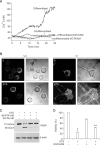Calcium overload is essential for the acceleration of staurosporine-induced cell death following neuronal differentiation in PC12 cells
- PMID: 19299916
- PMCID: PMC2679238
- DOI: 10.3858/emm.2009.41.4.030
Calcium overload is essential for the acceleration of staurosporine-induced cell death following neuronal differentiation in PC12 cells
Abstract
Differentiation of neuronal cells has been shown to accelerate stress-induced cell death, but the underlying mechanisms are not completely understood. Here, we find that early and sustained increase in cytosolic ([Ca2(+)]c) and mitochondrial Ca2(+) levels ([Ca2(+)]m) is essential for the increased sensitivity to staurosporine- induced cell death following neuronal differentiation in PC12 cells. Consistently, pretreatment of differentiated PC12 cells with the intracellular Ca2(+)-chelator EGTA-AM diminished staurosporine-induced PARP cleavage and cell death. Furthermore, Ca2(+) overload and enhanced vulnerability to staurosporine in differentiated cells were prevented by Bcl-XL overexpression. Our data reveal a new regulatory role for differentiation-dependent alteration of Ca2(+) signaling in cell death in response to staurosporine.
Figures




References
-
- Beal MF. Mitochondrial dysfunction in neurodegenerative diseases. Biochim Biophys Acta. 1998;1366:211–223. - PubMed
-
- Boise LH, Gonzalez-Garcia M, Postema CE, et al. bcl-x, a bcl-2-related gene that functions as a dominant regulator of apoptotic cell death. Cell. 1993;74:597–608. - PubMed
-
- Demaurex N, Distelhorst C. Cell biology. Apoptosis--the calcium connection. Science. 2003;300:65–67. - PubMed
-
- Desagher S, Martinou JC. Mitochondria as the central control point of apoptosis. Trends Cell Biol. 2000;10:369–377. - PubMed
-
- Dong Z, Saikumar P, Weinberg JM, et al. Calcium in cell injury and death. Annu Rev Pathol. 2006;1:405–434. - PubMed
Publication types
MeSH terms
Substances
LinkOut - more resources
Full Text Sources
Research Materials
Miscellaneous
